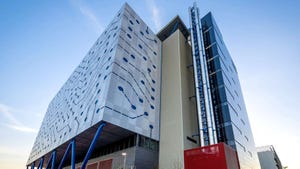Data Center Industry Survey Highlights Cost, AI, and Sustainability ChallengesData Center Industry Survey Highlights Cost, AI, and Sustainability Challenges
While opportunities abound, the Uptime Institute’s latest data center survey reveals key insights into rising operational costs, AI’s impact on rack density, and sustainability gaps.

The Uptime Institute has released its 14th annual Global Data Center Survey, offering a wide-ranging look at an industry poised for significant transformation.
Conducted in the first half of 2024, the survey provides insights into the practices and challenges faced by data center owners and operators worldwide.
Key findings of the report include:
Industry average Power Usage Effectiveness (PUE) remains at 1.56 – flat for the fifth consecutive year
Only 41% of operators track water usage for sustainability purposes
Trust in AI for operational decisions has fallen to 58%, down from 76% in 2022
33% of operators are developing new capacity to handle high-density cabinets
80% of operators believe recent downtime incidents were preventable
Operational Costs Emerge as Top Concern
In a significant shift from previous years, the Uptime Institute report reveals that cost has emerged as the primary concern for digital infrastructure management.
“Certainly, if you go to some of the industry events and you see the amount of investment going into the sector and the amount of money that’s been spent, you wouldn’t think this is an industry that worries about costs,” Andy Lawrence, executive director of research at Uptime Institute, explained during a webinar detailing the study’s findings on July 31.
“But actually, the cost of building and operating data centers after a fairly sustained period where they were drifting downloaders has gone up in the last several years.”
Lawrence attributed this rise to global inflation, supply chain issues following COVID-19, high energy prices, staff shortages, and overall strong demand.
Power Usage Effectiveness Remains Stable
The survey revealed that the industry’s average Power Usage Effectiveness (PUE) – a key sustainability metric – has remained relatively stable in recent years, hovering around 1.55.
PUE has long been a foundational metric for data centers. In an interview with Data Center Knowledge earlier this year, Peter de Bock, program director of the US Department of Energy’s Advanced Research Projects Agency (ARPA-E), explained why PUE matters as a measure of sustainability.
As to why PUE is stagnant, there are a few reasons.
“Efficiency is not the only driving factor in an end data center design and operations, the other thing that’s competing for attention is availability,” Chris Brown, chief technical officer at Uptime Institute commented. “Availability is job one in the data center.”
Brown emphasized that data center operators are constantly balancing the need for increasing efficiency with maintaining required availability levels.
“Instead of solving for the maximum efficiency that we can get out of the data center, we have to solve for a coincident maximum between availability and efficiency,” Brown said. “So, I think with that reality we’re not going to see PUE meaningfully decrease significantly over the next few years.”
Sustainability overall wasn’t exactly a primary concern either. The survey highlighted a significant gap in sustainability reporting, with less than half of respondents tracking metrics like renewable energy consumption and water usage.
The need to improve sustainability at data centers remains a core topic. In July, a coalition of hyperscalers and vendors working together in the iMasons Climate Accord announced an effort to push for greater transparency in sustainability reporting.
AI Drives Some High-Density Deployments, But Business Applications Remain the Primary Driver
The survey indicated a gradual increase in server rack densities, with more facilities reporting average densities in the 7-10 kW range.
AI is not yet a significant driver of increased data center density, with only 23% of respondents citing AI workloads as driving their highest density deployments. The top driver is still standard business applications.
However, there is concern that AI could lead to extremely high-density rack deployments, potentially exceeding 100 kW per rack. This would require custom-built data centers and significant investments in power infrastructure that may be prohibitively expensive for many operators.
Brown commented that data center operators are struggling to predict the actual impact of AI on density and capacity planning, as there is a lack of real-world examples to base their forecasts on. This uncertainty is a major concern for the industry in his view.
Outages Decrease, But Financial Impact Remains Significant
Data center outages have slightly decreased in frequency and severity, but their financial impact remains substantial. The survey found that about 20% of impactful outages cost over $1 million.
Power-related issues continue to be the leading cause of outages, accounting for over half of all significant incidents.
“Everything in a data center uses power and power is fairly binary, it’s either on or it’s off,” Brown said. “Power has so many more vectors by which to cause your data center problems and thus power is the biggest cause and probably will be the biggest cause for a long period of time.”
About the Author
You May Also Like









